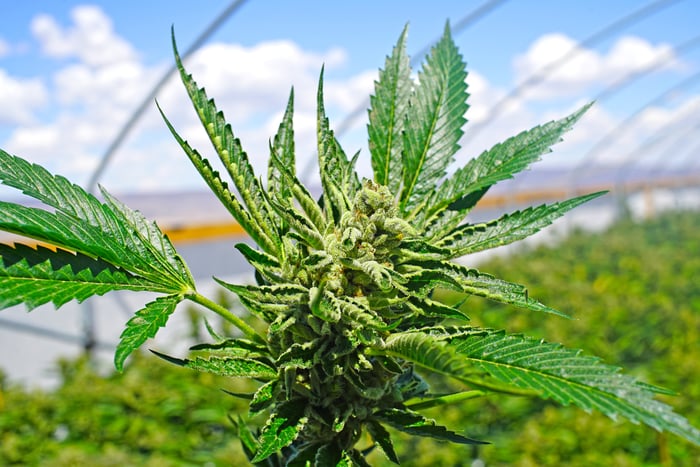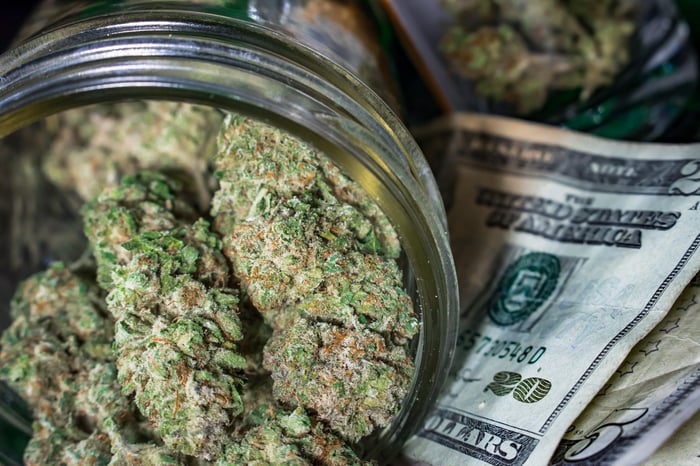The marijuana industry is growing by leaps and bounds, and investors are taking notice. Over the trailing year, a majority of the largest pot stocks have doubled or tripled in value, or in rarer instances, headed even higher. These strong gains come on the heels of rapid and consistent legal weed sales growth and an ongoing shift in the way the public views cannabis.
For example, Marijuana Business Daily's newest report, "Marijuana Business Factbook 2017," projects that legal cannabis sales will advance by 45% in 2018, largely due to California opening its doors to recreational weed sales. As a whole, this report estimates a quadrupling in legal sales in the U.S. between 2016 and 2021 to approximately $17 billion.

Image source: Getty Images.
We've also had no shortage of polls showing overwhelming support among the public for legalizing recreational and medical marijuana. In Oct. 2017, Gallup found that nearly two-thirds of Americans favored the idea of nationwide legalization. Similarly, the independent Quinnipiac University in August found that a whopping 94% of respondents favored OK'ing the use of medical cannabis, with a mere 4% opposing the prospect of legalization.
This progressive thinking is a big reason 29 states have legalized medical weed since 1996, and nine states have voted in favor of green-lighting adult-use marijuana since Nov. 2012. This latter group includes Vermont, which became the first to do so entirely through the legislative process this past week.
Ka-ching! America's first legal-marijuana state is raking in the dough
Colorado was part of the very first group, along with Washington state, to have voted to legalize recreational marijuana back in November 2012. Colorado wound up beating Washington to the punch when it came to opening its doors to adult-use sales. In a way, you could rightly refer to Colorado as America's first legal-weed state. Since opening its doors to recreational marijuana in 2014, sales and tax revenue collected have both soared.

Image source: Getty Images.
Here's a quick rundown of aggregate marijuana sales between 2014 and 2017:
- 2014: $699 million.
- 2015: $996 million.
- 2016: $1.3 billion.
- 2017: $1.49 billion.
For those of you who are a bit math-phobic, that's roughly 42% growth in 2015, more than 30% sales growth in 2016, and nearly 15% sales growth last year. It also translated into approximately $135 million in tax revenue collected by the state in 2015, almost $194 million in 2016, and $247.4 million last year. Remember, the tax revenue generated by cannabis sales primarily goes to fund schools, law enforcement, and statewide drug abuse assistance and awareness programs.
What was also notable about the $1.49 billion sold in Colorado last year is that we saw a decline in medical cannabis sales for the first time. According to estimates from GreenWave Advisors, medical cannabis sales dropped to $420 million from $430 million. Comparably, recreational sales surged 30% to an estimated $1.07 billion. This is a trend that's liable to continue since medical patients no longer have to go through the usual medical channels to obtain cannabis. Instead, they can just walk into any licensed dispensary and buy the product.
Colorado sales aside, the U.S. is at a major disadvantage
But in spite of having perhaps the most lucrative marijuana market in the world -- California alone may generate more in recreational weed sales than all of Canada -- the U.S. brings a number of disadvantages to the table that make it a market to avoid for most investors.

Image source: Getty Images.
To begin with, most U.S.-based cannabis companies have little to no access to basic financial services, which includes lines of credit or even a checking account. Financial institutions in the U.S. report to the Federal Deposit Insurance Corporation (FDIC), and since the FDIC is a federally created entity, any services provided by banks to pot companies could be viewed as money laundering, resulting in possible fines and/or criminal charges.
U.S. cannabis companies are also constrained by U.S. tax code 280E. This more than three-decade-old tax rule disallows businesses that sell a federally illegal substance from taking normal corporate income-tax deductions. The end result is that American pot businesses often pay an effective tax rate (if profitable) of between 70% and 90%.
The U.S. marijuana market is also highly fragmented. While I'm sure that consumers appreciate the impact small businesses have had on the legal weed industry in certain states, this lack of consolidation hurts production costs and makes it considerably tougher for legal weed businesses to compete with the black market on price.
And, of course, we can't forget about Attorney General Jeff Sessions, who has essentially declared war on the marijuana industry. Last year, Sessions requested the Rohrabacher-Blumenauer Amendment be repealed -- this is the amendment that disallows the Justice Department from using federal dollars to prosecute medical cannabis businesses in legal states -- and more recently he rescinded the Cole memo. This memo comprised a loose set of "rules" that legalized states agreed to abide by in order to keep the federal government off their backs. Without this memo in place, state prosecutors will have the discretion to bring charges against individuals or businesses.
Canada is the cannabis model other countries should follow
Though no country is perfect, Canada offers what's arguably the best model for success in selling legal weed. Canada wound up legalizing medical cannabis in 2001, and its medical business has been overseen by Health Canada ever since. Health Canada fairly tightly regulates licensing, which has been paramount in controlling production (and thus pricing).

Image source: Getty Images.
More interestingly, Canada's marijuana industry is highly consolidated. Even though Health Canada has expanded the number of licenses it's issued to growers in response to growing medical patient demand, four growers are expected control roughly half of the industry: Canopy Growth Corp. (CGC -3.13%), Aphria (NASDAQOTH: APHQF), Aurora Cannabis (ACB -1.86%), and MedReleaf. This consolidation has been the key to lowering growth costs and making legal cannabis price-competitive with the black market.
In addition, Canada is also working through legislation designed to legalize recreational weed by July. Progressives remain firmly in control of Canada's parliament, and the federal government recently worked out a tax-sharing agreement with the country's provinces that'll help keep legal weed price-competitive with the black market. Whereas the U.S. is all about generating tax revenue to offset state budget deficits, Canada's focus is on driving out black-market growers.
And lastly, Canada has the capacity to meet growing demand as a result of medical weed patient growth and a likely recreational legalization. The aforementioned Canopy Growth Corp. had 2.4 million square feet of capacity in development or under construction in British Columbia as of the end of the second quarter, with another 1.7 million square feet available for lease.
Meanwhile, Aphria and Aurora Cannabis are both working on flagship projects designed to dramatically boost production and lower long-term costs. Aphria's four-phase, $100 million-plus, project should yield 100,000 kilograms of dried cannabis a year once complete in January 2019. As for Aurora Cannabis, its 800,000-square-foot Aurora Sky project looks to be complete by mid-2018, yielding in excess of 100,000 kilograms of dried cannabis annually.
My suggestion would be to ignore the rapid marijuana growth figures from U.S. states, because there's virtually no way for investors to take advantage of that growth. Instead, look to our neighbors to the north if you're looking to take part in the green rush.




